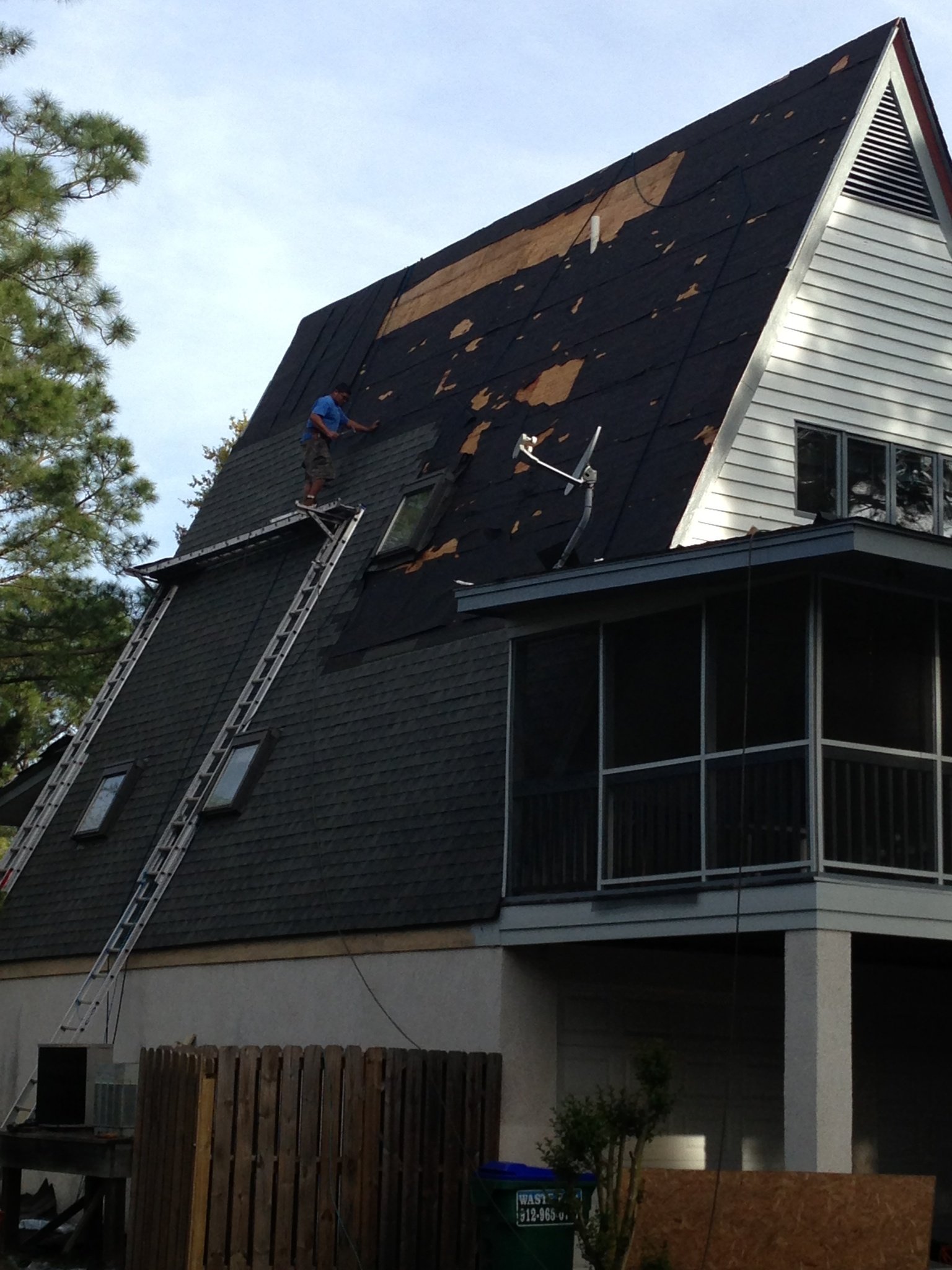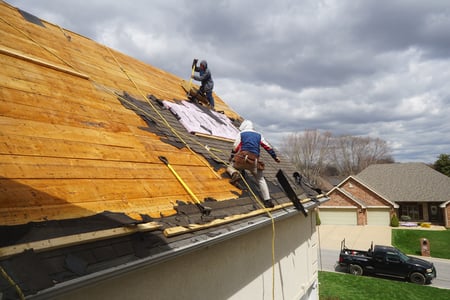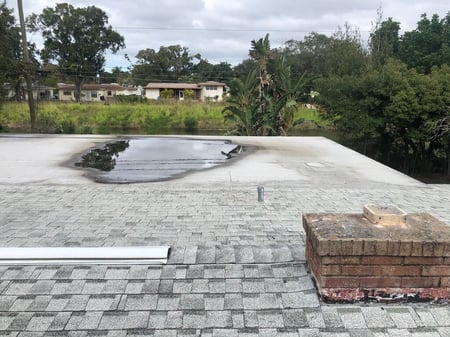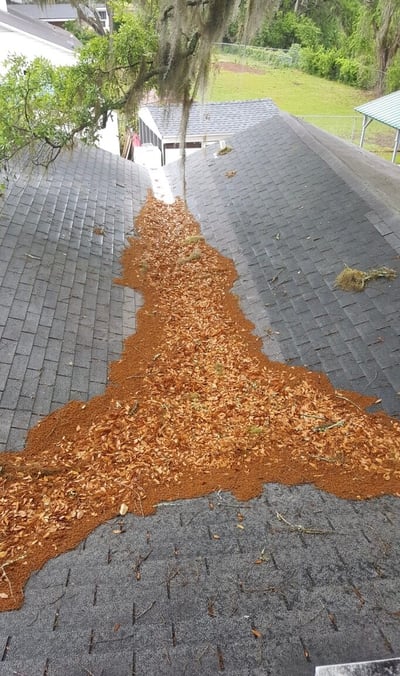Why Does Water Ponding Cause Leaks on Steep Pitch Roofs?
November , 2023 | 5 min. read
By David Toth

Although steep-pitched roofs are engineered to swiftly remove water, the occurrence of water ponding, although it’s rare, can present significant challenges. Their design aims to prevent water accumulation by facilitating quick drainage. However, when water does collect on these roofs, it usually signifies underlying concerns, whether stemming from structural flaws, design intricacies, or environmental influences that demand immediate attention.
During our nearly three decades in the roofing industry at RoofCrafters, we've encountered many roofing peculiarities, including the occurrence of water ponding on steep pitch roofs. Understandably, this can cause distress for homeowners, prompting the inevitable question: Why is this happening to me?
That being said, understanding the causes and implications of water ponding on a steep-pitched roof is essential for homeowners seeking to safeguard their roofs from potential damage and maintain their functionality over time. So, to find out why this may be happening to you, read ahead to learn what classifies as a steep-pitch roof, what water ponding is, why is it happening to your steep-pitch roof, and why this water ponding may be causing leaks. Let’s get started!
What is a Steep Pitch Roof?

A steep pitch roof refers to a roofing structure with a high angle of slope, typically greater than 45 degrees. This design is easily recognizable by its sharp incline, creating a significant vertical rise for every horizontal foot. Steep pitch roofs are often seen in traditional and historical architecture, though they also serve practical purposes in modern construction. Their steep angle allows for efficient water drainage, snow shedding, and increased attic or loft space. Additionally, these roofs can enhance ventilation and can offer a more striking aesthetic to a building's overall design.
What Is Water Ponding?

Water ponding on a roof refers to the accumulation of standing water or puddles that remain on the roof surface after rainfall or due to improper drainage. This occurs when the roof doesn't have enough slope or when there are structural issues preventing water from properly draining off the roof. Ponding water on a roof can be problematic as it can lead to various issues such as:
Leakage: Prolonged standing water can seep through the roof membrane or roofing materials, causing leaks into the building.
Structural damage: The weight of the pooled water can stress the roof structure, potentially causing damage over time.
Deterioration: Standing water can degrade roofing materials, reducing their lifespan and effectiveness.
Mold and mildew: Moisture accumulation provides a breeding ground for mold and mildew, which can affect indoor air quality and pose health risks.
It's essential to address water ponding issues promptly by improving the roof's drainage system, ensuring proper slope, and potentially considering roof repairs or modifications to prevent further water accumulation. Regular roof inspections and maintenance can help identify and rectify ponding issues before they cause significant damage.
Why Would Water Pond on a Steep Pitch Roof?
While water ponding is less common on steep-pitched roofs compared to flat or low-slope roofs, it's not entirely impossible. Steep-pitched roofs are designed to facilitate water drainage more efficiently due to their angle, allowing water to run off more quickly than on flat surfaces. However, several factors can still contribute to water ponding on a steep-pitched roof:

Obstructions: Debris, such as leaves, branches, or other materials, can hinder water flow and create pockets where water accumulates.
Damaged or inadequate drainage: If the roof's drainage system is compromised or insufficient, such as clogged gutters or downspouts, water might pool in certain areas.
Irregularities in roof construction: Minor design flaws, improper installation, or irregularities in the construction of the roof can create areas where water collects.
Ice dams: In colder climates, ice dams can form on steep-pitched roofs, blocking the natural flow of melting snow and leading to water ponding.
Why Does Water Ponding Cause Leaks on Steep Pitch Roofs?
Water ponding on a steep pitch roof can lead to leaks due to the prolonged presence of water in specific areas. While steep roofs are designed for efficient water drainage, if water accumulates or ponds in any localized spot due to debris, inadequate drainage, or improper installation, it can seep through the roofing materials.
Over time, this continuous exposure to pooled water can compromise the integrity of the roof, causing leaks or even structural damage as it penetrates beneath shingles or roofing layers, leading to potential water infiltration into the home. Luckily, there are several ways to mitigate water ponding on a steep pitch roof:
.png?width=1200&height=200&name=Recommended%20Reading%20(50).png)
Improve drainage: Ensure that gutters, downspouts, and drainage systems are clear of debris and are properly directing water away from the roof. Adding additional downspouts or enlarging gutters can enhance water flow.
Regular maintenance: Regularly inspect the roof for any debris, such as leaves or branches, that could obstruct water flow. Promptly remove anything that could impede proper drainage.
Corrective measures: If certain areas consistently accumulate water, consider corrective measures such as adjusting the slope slightly or installing crickets or tapered insulation to redirect water towards drains.
Professional inspection: Have a roofing professional assess the roof to identify any structural issues or design flaws contributing to ponding. They can provide tailored solutions to mitigate the problem effectively.
Roof coatings or membranes: Applying specialized coatings or membranes can provide an additional layer of protection against water penetration and help improve the roof's ability to shed water.
Regular roof inspections: Conduct routine inspections to catch any potential ponding issues early on. Early detection allows for timely repairs and prevents further damage.
Remember, addressing water ponding promptly is crucial to prevent leaks and maintain the integrity of your steep-pitch roof. Consulting with a roofing specialist is often the most effective way to tackle this issue based on your roof's specific design and conditions.
Understanding Water Ponding on Steep Pitch Roofs
As you now know, water ponding on a steep pitch roof can occur due to various reasons, including inadequate drainage systems, debris blockage, improper installation, or structural irregularities. Understanding these potential causes is crucial in implementing effective mitigation strategies.
By addressing issues such as clogged gutters, structural adjustments, regular maintenance, and professional inspections, it's possible to minimize the risk of water accumulation. Proactive measures not only prevent ponding but also safeguard the roof against potential leaks and structural deterioration, ensuring its longevity and optimal functionality.
If you suspect you may be dealing with water ponding on your steep pitch roof, be sure to hit the “Schedule an Inspection” button down below, and one of our roofing experts will thoroughly examine your roof and walk you through your options!
My name is David Toth and I am the lead estimator in North Florida with RoofCrafters Roofing. Originally from New Brunswick, I have called Florida home for the past 47 years. I enjoy cooking along with traveling to different historical areas in Florida when I have free time.



